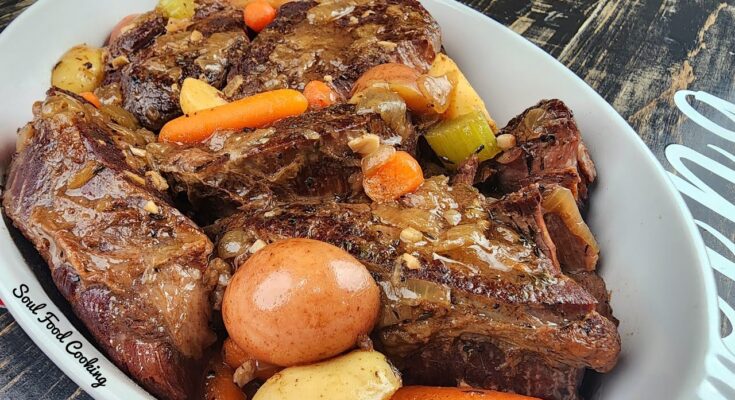Pot Roast Recipe: Pot roast is a timeless comfort food. There’s something deeply satisfying about slow-cooked, tender meat with flavorful vegetables.
Whether you’re preparing it for a cozy family dinner or a special occasion, pot roast brings warmth and comfort to the table.
In this step-by-step guide, I’ll walk you through the entire process of making a perfect pot roast from choosing the right cut of meat to serving it with the best sides.
What is a Pot Roast?
Pot roast refers to a method of cooking a large cut of tough meat, slowly, over a long period of time. The meat is often browned first, then cooked at a low temperature with vegetables in a flavorful broth. This slow cooking process allows the meat to break down into a tender, melt-in-your-mouth dish.
Why is Pot Roast a Perfect Comfort Food?
Not only is pot roast hearty and filling, but it also fills the house with mouthwatering aromas while it cooks. It’s the perfect choice for colder weather, family gatherings, or when you just need something satisfying and easy to prepare.
Key Ingredients for a Perfect Pot Roast
To make a delicious pot roast, you’ll need a few simple but essential ingredients:
Main Ingredients:
- Beef Roast (Chuck roast is popular, but more on that later)
- Vegetables (carrots, potatoes, onions, celery)
- Beef Broth or Stock
- Seasonings (salt, pepper, garlic, thyme, bay leaves)
Optional Ingredients for Flavor Variations:
- Red wine (for a richer flavor)
- Mushrooms
- Fresh herbs like rosemary
- Tomato paste or Worcestershire sauce
Choosing the Right Cut of Meat
Best Meat Cuts for Pot Roast:
The best cuts of beef for pot roast come from the tougher parts of the animal that benefit from slow cooking:
- Chuck Roast: The classic choice, well-marbled, and flavorful.
- Brisket: A fattier option that gets incredibly tender.
- Round Roast: Leaner but still works well with slow cooking.
Why the Cut Matters:
Choosing the right cut is crucial. Pot roast is all about turning tougher, more affordable cuts into something tender and succulent. Cuts like chuck roast contain a lot of connective tissue that breaks down beautifully during slow cooking.
Preparing the Meat for Pot Roast
Trimming and Seasoning the Meat:
Start by trimming any excess fat from the meat. Then, generously season the roast on all sides with salt, pepper, and your preferred spices. A simple rub of garlic powder, thyme, and a pinch of paprika works great for added flavor.
Marinating the Meat (Optional):
While not necessary, marinating the meat in broth, red wine, or a blend of spices can infuse it with deeper flavors. You can marinate for a few hours or overnight in the refrigerator.
Step-by-Step Guide to Cooking Pot Roast
Prepping the Vegetables:
Cut your vegetables into large chunks. Carrots, potatoes, onions, and celery are classic choices, but you can add others like parsnips or sweet potatoes for variety. These will add depth to the flavor of the dish and make for a hearty meal.
Searing the Meat:
Searing the roast is a critical step. Heat oil in a large pan or Dutch oven over medium-high heat and brown the roast on all sides. This creates a rich crust that enhances both the flavor and texture of the final dish.
Deglazing the Pan for Extra Flavor:
After searing, there will be browned bits stuck to the bottom of the pan. These are flavor gold! Deglaze the pan by adding a bit of broth, red wine, or water to loosen those bits, then pour this flavorful liquid over the roast.
Slow Cooking vs Oven Roasting:
You have options when it comes to how you cook your pot roast:
- Slow Cooker: Set on low for 8-10 hours or high for 4-5 hours.
- Oven Roasting: Roast at 275°F (135°C) for 3-4 hours in a covered Dutch oven.
Cooking Methods
Using a Dutch Oven:
A Dutch oven is perfect for pot roast. After searing the meat and deglazing the pan, cover and roast the meat in the oven, ensuring a moist, flavorful result.
Crockpot (Slow Cooker) Method:
If using a slow cooker, you can simply add the seared meat and vegetables, pour in the broth, and let the slow cooker do the work. This method is incredibly convenient.
Instant Pot Method:
For faster results, use an Instant Pot. Sear the meat on the sauté setting, add the broth and vegetables, then cook on high pressure for about 60-70 minutes, followed by a natural release.
Adding Vegetables for Extra Flavor
Best Vegetables for Pot Roast:
Root vegetables like carrots and potatoes work well since they can withstand long cooking times. You can also add onions, celery, and garlic for enhanced flavor.
Timing for Adding Vegetables:
Add the vegetables halfway through cooking to prevent them from getting mushy. This will allow them to stay tender while still absorbing the rich flavors from the broth.
Flavorful Add-Ons
Fresh Herbs and Spices:
Add sprigs of fresh thyme or rosemary to the pot, or toss in a couple of bay leaves for an earthy depth of flavor.
Broths and Stocks:
Use beef broth or stock as your cooking liquid. For extra richness, you can also add a splash of red wine or a bit of tomato paste.
How Long to Cook Pot Roast
Cooking Time by Method:
- Slow Cooker: 8-10 hours on low, or 4-5 hours on high.
- Oven: 3-4 hours at 275°F (135°C).
- Instant Pot: 60-70 minutes on high pressure.
Signs the Roast is Ready:
The meat should be fork-tender, meaning it falls apart easily when pierced with a fork.
Tips for a Tender Pot Roast
The Importance of Low and Slow Cooking:
The key to tender pot roast is cooking it slowly at a low temperature. This allows the tough fibers in the meat to break down.
How to Avoid a Tough Pot Roast:
Make sure you don’t rush the cooking process. Cooking too quickly or at too high a temperature can result in tough, chewy meat.
Serving Suggestions
Side Dishes That Pair Well:
- Mashed potatoes
- Green beans
- Roasted vegetables
- Crusty bread
Classic Pot Roast Sauces and Gravies:
Drizzle the pot roast with the broth it was cooked in, or make a gravy by thickening the broth with flour or cornstarch.
Resting and Carving the Roast
Why Let It Rest?
Allow the roast to rest for about 10-15 minutes after cooking. This helps the juices redistribute, making the meat more succulent.
How to Carve Pot Roast for Maximum Tenderness:
Use a sharp knife and slice against the grain to ensure each bite is tender.
Common Mistakes to Avoid
- Overcooking or Undercooking: Check the meat’s tenderness with a fork before deciding it’s done.
- Not Searing the Meat: Skipping this step results in less flavor.
- Skipping the Deglazing Step: Those browned bits on the pan add tons of flavor!
Storing and Reheating Pot Roast
Best Practices for Leftovers:
Store leftovers in an airtight container in the fridge for up to 4 days, or freeze for up to 3 months.
How to Reheat Without Drying Out the Meat:
Reheat pot roast gently in the oven, covered, at 300°F (150°C) with a splash of broth to keep it moist.
FAQs about Pot Roast Recipe
1. What is pot roast?
Pot roast is a classic comfort dish made by slow-cooking a tough cut of beef, like chuck roast or brisket, in a flavorful broth. The low, slow cooking process helps to tenderize the meat, resulting in a rich, savory meal.
2. What is the best cut of meat for pot roast?
Popular cuts include chuck roast, brisket, or round roast. These cuts have the right amount of fat and connective tissue, which break down during slow cooking to create a tender, flavorful roast.
3. How long should I cook a pot roast?
Typically, a pot roast takes about 3-4 hours to cook in the oven at 300°F (150°C) or 6-8 hours in a slow cooker on low. The key is cooking it low and slow until the meat is fork-tender.
4. Can I add vegetables to the pot roast?
Yes! Carrots, potatoes, and onions are classic additions. They absorb the flavors from the broth and add texture to the dish.
5. How do I thicken the pot roast gravy?
After removing the roast, you can thicken the remaining liquid by whisking in a slurry of cornstarch or flour with water. Let it simmer for a few minutes until it reaches the desired consistency.
Conclusion
Pot roast has earned its place as a classic comfort meal because it brings together hearty ingredients, rich flavors, and a sense of warmth that feels like home. The slow-cooked tenderness of the beef, combined with flavorful vegetables and savory broth, creates a dish that’s both satisfying and nostalgic.
Whether enjoyed on a chilly evening or as a family dinner, pot roast delivers the perfect balance of taste and comfort, making it a go-to choice for generations. Its simplicity and ability to feed a crowd make it timeless, ensuring it will remain a favorite for years to come.



